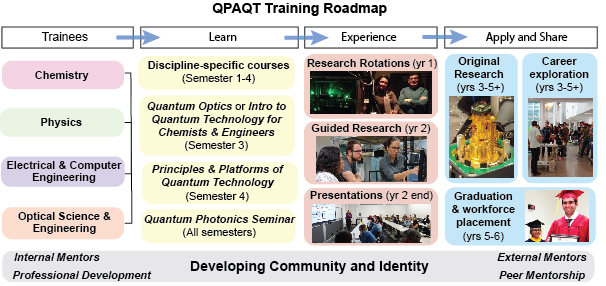Vision
Quantum Science & Technology harnesses the unique features of quantum mechanical systems, such as superposition and entanglement, for devices that hold the promise to revolutionize future technologies in computing, communication, and sensing, and deepen our understanding of the universe. The QPAQT program trains UNM graduate students to be generalists in Quantum Science & Technology and gives them the tools and academic preparation for a wide variety of applications.
Seeded by a $3M grant from the National Science Foundation, NRT-QL: Quantum Photonics interdisciplinary training to Advance Quantum Technologies, the University of New Mexico has started a new graduate program in Quantum Photonics and Quantum Technology (QPAQT). A vibrant graduate program at the intersection of physics, chemistry, and engineering, QPAQT will train students to be generalists in quantum technology and give them the tools and academic preparation for a wide variety of Quantum Science & Technology applications. Read the UNM Newsroom article for more information.
Program details
QPAQT offers 12-15 month fellowships for UNM PhD students, typically in their second year.
Trainees are admitted to the program at the start of their graduate education and take QPAQT coursework at the start of their 2nd year, after most of their home department's PhD course requirements are completed.
Students who complete the QPAQT program will receive a transcripted Graduate Certificate in Quantum Science & Technology (established Fall 2024).
The curriculum is:
- Core course #1 (offered in Fall):
- Either CHEM573/ECE573 - Introduction to Quantum Technology for Chemists and Engineers
- Or PHYS566 - Quantum Optics
- Core course #2 (offered in Spring):
- PHYS575/CHEM575/ECE587 - Principles and Platforms of Quantum Technology
- Complete at least one of the following electives:
- CHEM567 - Topics in Physical Chemistry (Quantum Computing for Quantum Chemistry, Applied Machine Learning, Density Functional Theory, etc.)
- CHEM505 - Molecular Simulation
- CHEM501 - Molecular Structure Theory
- CHEM504 - Chemical Dynamics
- PHYS545/ECE545 - Introduction to Quantum Information Science
- PHYS571 - Quantum Computation
- PHYS572 - Quantum Information Theory
- PHYS476L/PHYS477L - Experimental Techniques of Optics
- PHYS463/ECE463 - Advanced Optics I
- PHYS554/ECE554 - Advanced Optics II
- ECE564 - Guided Wave Optics
- ECE547 - Quantum Error Correction (3)
- Participate in the CHEM 625/ECE 595/PHYS 500 Quantum Photonics Seminar
- Participate in Faculty-guided research with one of the QPAQT faculty and earn three 650 Research or 551 Problems credits culminating in a successful Capstone presentation.
Eligibility
Any student who has already been admitted to a UNM PhD program in Chemistry, Engineering, OSE, or Physics, and is interested in doing Quantum Technology research with one of the QPAQT faculty may apply.
How to apply
After you have been admitted to a UNM PhD program, you may apply for the QPAQT program (2025 deadline: Monday, March 31). The application is short and should not take a lot of time to complete. See How to Apply page for instructions.
QPAQT Fellowships and funding support
All students admitted to QPAQT will receive training perks which may include a conference travel budget, computer and software supplies, textbooks, and funds for activities like cleanroom training.
In addition a select number of students will receive 12-15 month fellowships with a stipend of $35k/yr (+tuition and medical insurance), to begin in their second year. Students must have a different source of funding (e.g. RA or TA) for their first academic year.
Participating QPAQT faculty
See the QPAQT faculty page for a list of program leadership and potential faculty research advisors.
Contact. Questions can be sent to qpaqt@unm.edu

